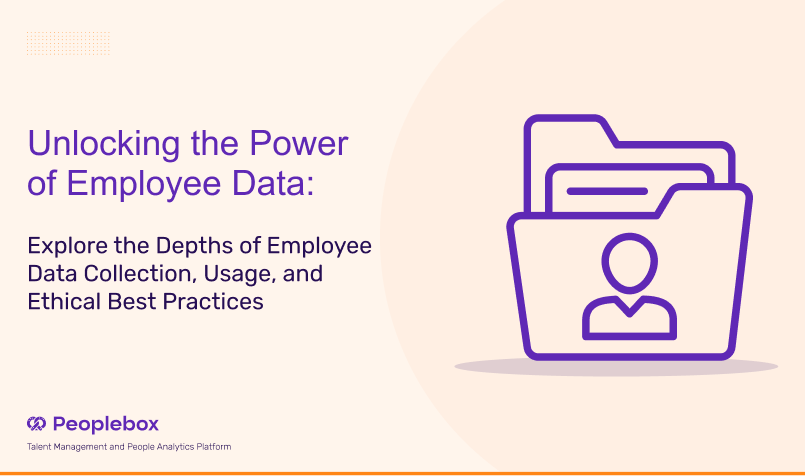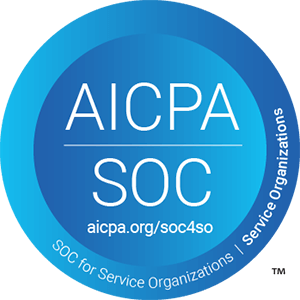When used correctly, employee data is more than just info about your team; it’s key to spotting trends in how employees work and what they need. It helps you make better plans to keep employees happy, make your operations smoother, and improve your company’s health.
We’ll go through what kinds of employee data there are, highlighting the unique purpose and utility of each. Then, we’ll cover different channels you can use to gather this data and best practices for managing it effectively. Lastly, we’ll show how you can truly unlock the full potential of employee data by using a people analytics software like Peoplebox.
Let’s get started.
Types of Employee Data & Examples
Let’s dive into the 13 types of employee data and their significance. Each type serves a unique purpose, from informing diversity initiatives to enhancing employee engagement and improving your recruiting processes.

1. Personal Information
- What It Includes: Names, dates of birth, and addresses
- Purpose:
- It helps identify employees within an organisation.
- It’s the initial set of data collected in the employee lifecycle, for administrative, legal, and emergency purposes.
2. Demographic Information
- What It Includes: Age, gender, ethnicity, disability status, veteran status.
- Purpose:
- Demographic data is important for developing diversity and inclusion strategies. It informs targeted initiatives to enhance workplace equity and representation.
- Equal opportunity monitoring (EOM) and reporting, ensuring adherence to legal standards.
3. Job-Related Data
- What It Includes: Position, department, job description, start date, employment details and status (full-time, part-time, contract, etc.), work location, and office assignment.
- Purpose:
- It highlights current workforce capabilities and identifies gaps. For example, it helps pinpoint areas where additional hiring is needed, whether for specific skills, roles that are currently unoccupied, or to enhance departmental capabilities.
- It shows workforce distribution and structure. This allows for a clear view of how employees are spread across various departments and locations. It can reveal whether certain areas are understaffed or overstaffed.
4. Compensation and Benefits Data
- What It Includes:
- Compensation data: Salary, bonuses, overtime pay, commissions, pay raises and history, pay grades and bands, equity or stock options
- Benefits data: health insurance, retirement plans, paid time off (PTO), parental leave, wellness programs, educational assistance, and any other perks like gym memberships, relocation assistance, free meals, etc.
- Purpose:
- It helps identify pay disparities to achieve fairness internally and in comparison to the industry.
- It helps ensure compliance with compensation-related laws and regulations, such as equal pay for equal work, overtime pay, and minimum wage.
- It helps offer benefits based on employee preferences and cost-effectiveness.
- It helps analyse the impact of compensation and benefits on employee retention, satisfaction, and recruitment efforts.
5. Attendance and Time Tracking
- What it includes:
- Basic attendance data: clock-in and clock-out times, total hours worked, late arrivals, early departures
- Time off and leaves: paid time off (vacation days, sick leave, and personal days), unpaid time off, maternity/paternity leave, bereavement leave, jury duty and other statutory leaves
- Advanced time tracking: project time tracking, overtime tracking (including overtime rates where applicable), break times (logs the duration and frequency of breaks taken during the workday)
- Purpose:
- Helps ensure adherence to local and federal labour laws regarding work hours, overtime, breaks, and minimum wage requirements.
- Detailed reports on attendance patterns, absenteeism rates, and other relevant metrics help management review employee attendance. For example, it helps identify patterns, such as recurring absenteeism or frequent late arrivals.
- Track of accrued and used PTO, sick leave, and other time off types, provides visibility for both employees and managers.
- Correlates work hours with output metrics to gauge productivity levels.
- Helps calculate labour costs associated with projects, departments, or the entire organisation.
6. Employee Engagement and Satisfaction
- What it includes:
- Employee Net Promoter Score (eNPS): Measures how likely employees are to recommend their workplace to friends and family, indicating their loyalty and satisfaction.
- Survey Results: Results of comprehensive questionnaires that assess various dimensions of employee engagement and job satisfaction.
- Participation Rates: Tracks the percentage of employees who participate in surveys and other engagement initiatives, which can be an indicator of overall engagement levels.
- Purpose:
- Identifies changes over time in engagement and satisfaction metrics, helping to pinpoint emerging issues or successes.
- Uses historical data to predict future trends in employee engagement and satisfaction, helping companies plan improvements ahead of time.
- It allows organisations to create a more positive work environment, tailor management practices to employee needs, and make informed decisions that boost morale and productivity.
7. Educational and Professional Background
- What it includes:
- Educational background: Degrees and certifications, institutions attended, field of study, academic achievements (for ex: awards, scholarships)
- Professional experience: Previous employers, past job titles, skills (including both hard skills and soft skills), notable accomplishments received in previous positions, ongoing learning and development activities (including workshops, seminars, and courses)
- Additional qualifications: languages, volunteer experience, publications and patents, professional memberships
- Purpose:
- Assess fit for current and potential future roles.
- Identify candidates for succession planning and leadership development programs.
- Tailor training and development initiatives to address individual and organisational needs.
- Cultivate an environment that prioritizes ongoing learning and career development.
8. Emergency Contact Information
- What it includes:
- Basic Contact Details: Contact’s name, relationship to the employee
- Contact Information: Primary phone number, secondary phone number (if any), email address, physical address
- Special Instructions: Preferred method of contact, any additional notes or relevant information the emergency contact or employee thinks the organisation should be aware of (e.g., specific medical conditions, preferred hospitals or doctors)
- Purpose:
- To ensure the safety and security of employees during emergencies or critical situations. This information allows organisations to quickly reach out to designated contacts in case an employee faces a health issue, accident, or any emergency while at work or during business-related activities.
9. Legal and Compliance Documents
- What it includes:
- Employment Agreements: Job responsibilities, salary, benefits, confidentiality obligations, termination conditions
- Tax Documents: W-4s or equivalent forms for tax withholdings, W-2s or 1099s for year-end tax reporting
- Work Eligibility Verification: eg. I-9 forms in the U.S. and required identification documents (e.g., passport, work visa)
- Background Checks: Criminal, financial, and employment verification reports
- Policy Acknowledgments: Employee signatures on company policy documents, such as codes of conduct and privacy policies
- Training Records: Documentation of mandatory compliance training completions (e.g., sexual harassment, data protection)
- Licences and Certifications: Details of required professional licences or certifications, including expiry and renewal information
- Disciplinary Records: Documentation related to disciplinary actions, reasons, and outcomes
- Accommodation Requests: Records of requests and approvals for accommodations under disability laws or other relevant statutes
- Audit Documentation: Records demonstrating compliance with legal and regulatory standards, used for audits
- Purpose:
- Ensures adherence to laws and regulations, avoiding penalties and reputational damage.
- Documents agreements and policies that safeguard employee interests and rights.
- Provides a basis for resolving disputes with factual documentation.
- Tracks completion of mandatory training sessions, especially those related to compliance, ethics, and safety.
10. Performance Metrics and Goals
- What it includes:
- Performance Metrics: Productivity metrics (e.g., sales targets achieved, units produced), quality metrics (e.g., customer satisfaction scores, compliance with standards), efficiency metrics (e.g., cost per unit of output), innovation and initiative contributions.
- Goals and Objectives: Individual goals (SMART objectives aligned with roles), team goals (collective objectives for collaboration), and organisational objectives (e.g., revenue targets, market expansion).
- Performance Reviews and Feedback: Self-assessments, manager assessments, peer feedback, and continuous feedback throughout the year for ongoing improvement.
- Development and Growth: Professional development plans for career growth and performance improvement, succession planning details including readiness for higher roles and development needs.
- Purpose:
- Helps in recognising achievements and areas for improvement, guiding performance management processes.
Suggested Read: Ultimate Guide to Performance Management Planning
11. Training and Development
- What it includes:
- Training Programs: Details on completed, ongoing, and planned courses, workshops, and seminars, including content focus and completion dates.
- Skills and Competencies: Specific skills or competencies gained from training, relevant to the employee’s role and organisational goals.
- Development Plans: Customised plans outlining career progression opportunities and required training.
- Effectiveness and Feedback: Evaluations of training impact on performance and skill applicability.
- Compliance Training: Documentation of completed mandatory training for regulatory compliance.
- Training Investment: Data on costs and resources allocated to training and development, supporting budgeting and investment analysis.
- Purpose:
- Identifying development opportunities for employees
- Aligning training programs with organisational goals
- Links training programs to performance improvements, helping to identify the most effective initiatives for enhancing employee productivity and quality of work.
- Measures the impact of training and development investments on business outcomes
12. Exit and Termination Records
- What it includes:
- Reasons for Leaving: Categorises exits such as resignation, retirement, termination, or layoff.
- Exit Interview Summaries: Insights and key takeaways from exit interviews, with suggestions for organisational improvements.
- Last Day of Employment: The employee’s final working day, important for administrative closure and security protocols.
- Employment Length: Duration of the employee’s tenure with the organisation
- Termination Details: For involuntary exits, details including the rationale for termination, documentation of the process, and any legal considerations.
- Post-Employment Information: Information on whether the departure was amicable and if the individual is eligible for rehire.
- Turnover Rates: Calculation of turnover metrics
- Purpose:
- Provides insights into employee turnover. Analysing the reasons behind employee departures, and identifying patterns or trends may indicate underlying issues within the organisation, such as management practices, compensation, work-life balance, or career development opportunities.
- By understanding why employees leave, organisations can develop targeted retention strategies.
- Insights from exit data can highlight skill gaps and competencies to look for in new hires. It also helps refine succession planning processes.
- Documentation related to terminations, especially involuntary ones, is necessary for legal compliance. It helps make sure that the organisation has followed fair and lawful processes, which can be important in the event of disputes or legal challenges.
- Helps manage costs related to recruitment, hiring, and training by reducing turnover.
13. Recruitment Metrics
- What it includes: Time to fill, cost per hire (including advertising, recruiter fees, and staff time), quality of hire (through performance ratings and retention rates), applicant sources (such as job boards, referrals, social media, etc.), application to interview ratio, interview to offer ratio, offer acceptance rate, new hire turnover (the rate at which new employees leave the organisation), diversity metrics (data on the diversity of applicants and hires), candidate satisfaction (i.e. candidates’ feedback on their recruitment experience).
- Purpose:
- Identify areas for improvement by tracking how long it takes to fill positions and hire candidates, helping reduce delays and inefficiencies.
- Improve candidate experience to increase offer acceptance rates.
- Determine the most effective sources for finding quality candidates, allowing organisations to allocate resources more effectively.
- It helps analyse the retention rates of new hires to evaluate the effectiveness of the recruitment and onboarding process, aiming to improve employee longevity.
Given the vast amount of useful employee data types available, you might be wondering where exactly you can begin to collect all this information.
Sources for employee data collection

employee data collection can be done through a variety of sources. Here are some key sources:
- HR Information Systems (HRIS): A centralised database that collects and stores data from various touch points throughout the employee lifecycle. HRIS can integrate data from payroll, benefits administration, performance management systems, and more.
- Applicant Tracking Systems (ATS): ATS are used during the recruitment process to collect and store resumes, cover letters, and applicant information. They help in tracking the progress of candidates through the hiring pipeline. Storing historical applicant data can be useful for understanding recruitment trends.
- Application forms and resumes: The initial source of data comes from the application process. Resumes, cover letters, and application forms provide a wealth of information about the candidate’s educational background, work history, skills, and competencies.
- Onboarding documents: When a new employee joins, they fill out various forms, such as tax forms (e.g., W-4 in the U.S.), benefits enrollment forms, and policy acknowledgement forms. These documents collect essential legal, financial, and personal information.
- Interviews: During the hiring process, interviews and assessments offer insights into a candidate’s capabilities, personality, and fit within the company culture. Behavioural assessments, skill tests, and situational interviews can also provide detailed data on a candidate.
- Employee surveys: Feedback on engagement, satisfaction, and workplace culture through anonymous surveys.
Discover how you can harness the power of employee engagement surveys to retain top talent
- Performance evaluations: Regular performance evaluations provide data on an employee’s achievements, strengths, areas for improvement, and career development plans. These can include manager assessments, peer reviews, and self-assessments.
- Time tracking and management software: Tools that monitor when employees clock in and out, their work hours, absences, and leave balances.
- Training and development records: Records of completed training sessions, certifications achieved, and skills acquired through company-provided or external professional development opportunities.
- Exit interviews: When employees leave the company, exit interviews can provide valuable information on their reasons for leaving, their experiences at the company, and suggestions for improvement.
Now that you understand how to collect employee data, it’s important to understand how to store and manage it compliantly and securely due to its sensitive nature.
Best Practices in Employee Data Management
Managing employee data effectively and ethically is a must in today’s workplace. Here are some best practices for managing employee data:
1. Data Privacy and Compliance
- Understand Legal Requirements: Familiarise yourself with local and international data protection laws (like GDPR in Europe, CCPA in California, etc.) that apply to your organisation. Ensure all employee data management practices comply with these regulations.
- Privacy Policy: Develop a clear privacy policy that outlines how employee data is collected, used, stored, and shared. Ensure employees have easy access to this policy.
2. Data Collection, Storage, and Management
- Minimise Data Collection: Collect only the data necessary for legitimate business purposes. Do not collect sensitive information unless necessary.
- Secure Storage Solutions: Use secure, encrypted databases to store employee data. Frequently update security measures to guard against breaches.
- Data Lifecycle Management: Have clear policies on the retention, archiving, and deletion of employee data. Make sure data is kept no longer than absolutely needed.
3. Access Control
- Limit Access: Ensure that only authorised personnel have access to employee data, and that access is based on the principle of least privilege (i.e., employees should only have access to the information necessary for their job functions).
- Authentication and Authorisation: Implement strong authentication methods and regularly review access permissions.
4. Data Accuracy and Integrity
- Regular Updates: Encourage employees to update their information regularly and provide easy ways for them to do so. Regularly audit the data for accuracy and completeness.
- Cross-validation with Multiple Data Sources: To further ensure the accuracy and integrity of employee data, employ cross-validation techniques by comparing information across multiple data sources. When discrepancies are found, investigate to determine the most accurate information before making any updates.
5. Transparency and Communication
- Open Communication: Communicate clearly with employees about how their data is being used and the measures in place to protect their information.
6. Data Use and Sharing
- Purpose Limitation: Use employee data solely for the purposes for which it was collected, as stated in your privacy policy.
- Third-Party Data Sharing: Be cautious when sharing data with third parties. Ensure they have strong data protection practices in place and are compliant with relevant laws.
7. Handling Data Breaches
- Incident Response Plan: Create and regularly update an incident response plan. This plan should include steps to take in the event of a data breach, including notifying affected individuals and regulatory bodies as required by law.
8. Regular Audits and Assessments
- Conduct Regular Audits: Regularly audit your data management practices and security measures to identify and address potential vulnerabilities.
- Risk Assessment: Perform risk assessments to understand the potential risks associated with employee data and to implement appropriate controls to mitigate these risks.
If you’re using an external vendor to collect and store employee information, review their compliance certifications and privacy policies.
Also read: Democratizing Employee Data
Peoplebox: Streamline Employee Data Collection for Better Insights
In today’s dynamic work environment, having a clear understanding of your employees’ performance, engagement, and development is critical. Peoplebox makes it easy for organizations to collect and analyze employee data in real time, providing actionable insights to drive improvements across the board.
Key features of Peoplebox that enhance employee data collection:
- Unified Dashboard: Centralize all employee data, from performance reviews to feedback and engagement metrics, in one place.
- Customizable Surveys: Gather data on employee satisfaction, engagement, and more with tailored surveys suited to your company’s specific needs.
- Automated Reporting: Generate comprehensive reports and visualizations, turning raw data into actionable insights with just a few clicks.
- Integrated OKR Tracking: Track employee progress and goal completion through integrated OKR features, providing valuable data on performance and alignment.
- Real-Time Analytics: Access real-time employee data to make faster, more informed decisions, identifying trends and addressing issues early.
With Peoplebox, you can simplify your employee data collection process and get the insights you need to create a more engaged and high-performing workforce and and patterns empowers HR teams to make quick, data-driven decisions – to make sure you stay competitive and fully leverage the insights employee data can offer.
Peoplebox provides OKR, Talent Management and People Analytics platform that helps companies attract, align and retain top performers. Leveraging cutting-edge Generative AI technology, we transform raw data from various work tools (SQL, Jira, Asana, Hubspot) into actionable insights. It also offers strategy execution and people-ops platform to convert those insights into tangible actions for growth and success.








